
Quick Navigation
Dovrefjell Sunndalsfjella National Park is located in Norway. The park covers an area of 654 square miles (1,693 sq km).
There are 10 additional protected areas, of which two are biotopes, that combine with the national park to create 1,686 square miles (4,366 sq km) of wilderness that is protected for future generations.
The heart of the park is grounded in the captivating picturesque views of the Dovrefjell mountain range. The striking summits tower over the luscious plains and valleys creating a diverse sanctuary of wilderness and wildlife.
The dramatic Dovrefjell mountain range is blanketed with snow throughout the majority of the year. This plateau of mountains combined with the drastically cold temperatures gives way to an Arctic-like ecosystem that supports the wildlife of the area.
The pinnacle wildlife of the park includes the country’s only remaining wild reindeer, wolverines, and the renowned musk oxen. Some of the other intriguing species of the area include arctic fox, the golden eagle, and the gyrfalcon.
Highlights
The pristine landscapes, majestic mountains, and unique wildlife are what most people identify as the highlights of the national park. The Dovrefjell mountain range is astounding and mountain experiences and highlights abound. The park is also home to the only remaining herd of wild reindeer in the country. For many, seeing these majestic creatures is a highlight.
Snohetta
Snohetta is a mountain in the Dovrefjell range. It reaches a summit height of 7,500 feet (2,286 m) making it the tallest mountain in the range and the pinnacle attraction of the national park.
It is the tallest mountain outside of the Jotunheimen range and the 24th highest summit throughout Norway. There are several peaks on the mountain with Stortoppen serving as the highest point.
The other peaks include Midttoppen, Hettpiggen, and Vesttoppen with all three being over 7,382 feet (2,250 m). Hiking and skiing are both activities used to engage the mountain.
 Musk Oxen
Musk Oxen
The Musk Oxen, also called Muskox or musk ox, is part of the Bovidae family. It features a long shaggy coat of hair and horns that are similar to the cape buffalo in Africa. The long hair and horns make it appear larger than it truly is.
Both males and females have these long-curved horns. They reach a shoulder height as much as 5 feet (1.5 m) and males reaching lengths as much as 8.2 feet (2.5 m). Females will be shorter in length reaching lengths up to 6.6 feet (2.01 m). The males can reach up to 900 pounds (410 kg), but the average is around 630 pounds (285 kg).
Dovrefjell-Sunndalsfjella National Park Trails
One of the exciting things for hikers is that Dovrefjell Sunndalsfjella is the perfect place to hike and explore. Many of the outings are in a pristine wilderness without the use of a designated trail.
Park Protection
The national park was created to preserve and protect the biodiverse alpine ecosystem which also supports important wildlife populations. The park protects the only remaining herd of wild reindeer in the country.
Musk Oxen became extinct years ago, however, the government in cooperation with Greenland reestablished a population of musk oxen. Protecting this species from future extinction is a top priority of the park’s conservation efforts.
Similarly, the park reintroduced the arctic fox which had become extinct from the area in 1990. The population appears to be holding and sustaining. Generically, the national park protects the exquisite pristine mountain wilderness and the striking landscapes. It also invests in the cultural heritage that is also found within the park boundaries.
Dovrefjell-Sunndalsfjella Highlights
- Snohetta
- Musk Oxen
- Wild Reindeer
Park Map
Sources
- All Trails, Best Trails in Dovrefjell Sunndalsfjella National Park, https://www.alltrails.com/parks/norway/trondelag/dovrefjell-sunndalsfjella-national-park, retrieved August 2020.
- Amazing Places, Dovrefjell National Park, https://www.amazingplaces.com/norway/dovrefjell-national-park/, retrieved August 2020.
- Europarc, Dovrefjell-Sunndalsfjella National Park, http://www.europarc-nb.org/protected-areas/norway/dovrefjell-sunndalsfjella-na/, retrieved August 2020.
- Fjord Norway, Dovrefjell-Sunndalsfjella National Park, https://www.fjordnorway.com/things-to-do/dovrefjell-sunndalsfjella-national-park-p1307923, retrieved August 2020.
- Lonely Planet, Welcome to Dovrefjell-Sunndalsfjella National Park, https://www.lonelyplanet.com/norway/dovrefjell-sunndalsfjella-national-park, retrieved August 2020.
- Nasjonalparkriket, Dovrefjell, https://www.nasjonalparkriket.no/en/dovrefjell-nasjonalpark, retrieved August 2020.
- Nordic Visitor, Dovrefjell Sunndalsfjella National Park, https://norway.nordicvisitor.com/travel-guide/attractions/east-norway/dovrefjell%E2%80%93sunndalsfjella-national-park/, retrieved August 2020.
- Switchback Travel, Dovrefjell Norway, https://www.switchbacktravel.com/norway/dovrefjell, retrieved August 2020.
- Visit Norway, Dovrefjell Sunndalsfjella National Park, https://www.visitnorway.com/places-to-go/fjord-norway/northwest/listings-northwest/dovrefjell-sunndalsfjella-national-park/11877/, retrieved August 2020.










